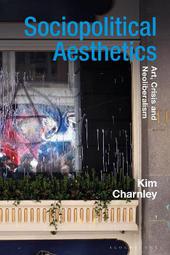
|
Sociopolitical Aesthetics: Art, Crisis and Neoliberalism
Paperback / softback
Main Details
| Title |
Sociopolitical Aesthetics: Art, Crisis and Neoliberalism
|
| Authors and Contributors |
By (author) Kim Charnley
|
| Series | Radical Aesthetics-Radical Art |
|---|
| Physical Properties |
| Format:Paperback / softback | | Pages:272 | | Dimensions(mm): Height 216,Width 138 |
|
| Category/Genre | Theory of art
Philosophy - aesthetics
Social and political philosophy |
|---|
| ISBN/Barcode |
9781350008731
|
| Classifications | Dewey:701.03 |
|---|
| Audience | | Tertiary Education (US: College) | |
|---|
| Illustrations |
15 b/w illus
|
|
Publishing Details |
| Publisher |
Bloomsbury Publishing PLC
|
| Imprint |
Bloomsbury Academic
|
| NZ Release Date |
8 April 2021 |
| Publication Country |
United Kingdom
|
Description
Since the turn of the millennium, protests, meetings, schoolrooms, reading groups and many other social forms have been proposed as artworks or, more ambiguously, as interventions that are somewhere between art and politics. This book surveys the resurgence of politicized art, tracing key currents of theory and practice, and mapping them against the dominant experience of the last decade: crisis. Drawing upon leading artists and theorists within this field - including Hito Steyerl, Marina Vishmidt, Art & Language, Gregory Sholette, John Roberts and Dave Beech - this book argues for a new interpretation of the relationship between socially-engaged art and neoliberalism. Kim Charnley explores the possibility that neoliberalism has destabilized the art system so that it is no longer able to absorb and neutralize dissent. As a result, the relationship between aesthetics and politics is experienced with fresh urgency and militancy.
Author Biography
Kim Charnley is Staff Tutor in Art History at The Open University, UK.
ReviewsSociopolitical Aesthetics is without doubt the best political analysis of art's 'social turn', which it revisits through a reexamination of the contested meanings of collectivity and a re-reading of debates on aesthetics and politics within the context of neoliberalism, the globalisation of contemporary art and narratives of crisis. Charnley combines first rate art historical scholarship with razor sharp political analysis and an insider's understanding of contemporary art to explain the rise of socially engaged art against the prevailing wisdom that art as an institution must neutralise dissent, through co-optation, absorption, incorporation, and recuperate and by turning politics into aesthetics. What if, Charnley asks, the art system has reached the limit of its ability to contain the critical practices that occupy it. * Dave Beech, Reader in Art and Marxism, University of the Arts London, UK *
|